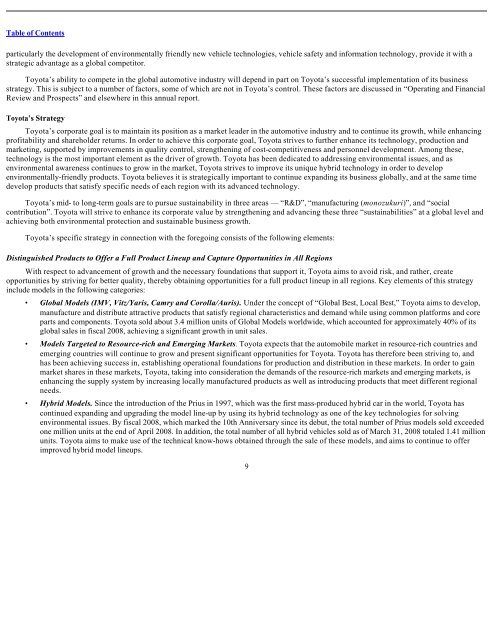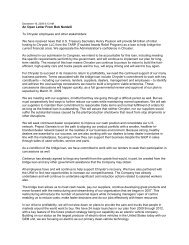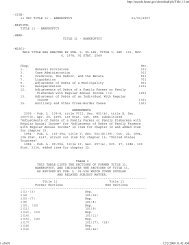toyota jidosha kabushiki kaisha toyota motor corporation - Big Three ...
toyota jidosha kabushiki kaisha toyota motor corporation - Big Three ...
toyota jidosha kabushiki kaisha toyota motor corporation - Big Three ...
You also want an ePaper? Increase the reach of your titles
YUMPU automatically turns print PDFs into web optimized ePapers that Google loves.
Table of Contents<br />
particularly the development of environmentally friendly new vehicle technologies, vehicle safety and information technology, provide it with a<br />
strategic advantage as a global competitor.<br />
Toyota’s ability to compete in the global automotive industry will depend in part on Toyota’s successful implementation of its business<br />
strategy. This is subject to a number of factors, some of which are not in Toyota’s control. These factors are discussed in “Operating and Financial<br />
Review and Prospects” and elsewhere in this annual report.<br />
Toyota’s Strategy<br />
Toyota’s corporate goal is to maintain its position as a market leader in the automotive industry and to continue its growth, while enhancing<br />
profitability and shareholder returns. In order to achieve this corporate goal, Toyota strives to further enhance its technology, production and<br />
marketing, supported by improvements in quality control, strengthening of cost-competitiveness and personnel development. Among these,<br />
technology is the most important element as the driver of growth. Toyota has been dedicated to addressing environmental issues, and as<br />
environmental awareness continues to grow in the market, Toyota strives to improve its unique hybrid technology in order to develop<br />
environmentally-friendly products. Toyota believes it is strategically important to continue expanding its business globally, and at the same time<br />
develop products that satisfy specific needs of each region with its advanced technology.<br />
Toyota’s mid- to long-term goals are to pursue sustainability in three areas — “R&D”, “manufacturing (monozukuri)”, and “social<br />
contribution”. Toyota will strive to enhance its corporate value by strengthening and advancing these three “sustainabilities” at a global level and<br />
achieving both environmental protection and sustainable business growth.<br />
Toyota’s specific strategy in connection with the foregoing consists of the following elements:<br />
Distinguished Products to Offer a Full Product Lineup and Capture Opportunities in All Regions<br />
With respect to advancement of growth and the necessary foundations that support it, Toyota aims to avoid risk, and rather, create<br />
opportunities by striving for better quality, thereby obtaining opportunities for a full product lineup in all regions. Key elements of this strategy<br />
include models in the following categories:<br />
• Global Models (IMV, Vitz/Yaris, Camry and Corolla/Auris). Under the concept of “Global Best, Local Best,” Toyota aims to develop,<br />
manufacture and distribute attractive products that satisfy regional characteristics and demand while using common platforms and core<br />
parts and components. Toyota sold about 3.4 million units of Global Models worldwide, which accounted for approximately 40% of its<br />
global sales in fiscal 2008, achieving a significant growth in unit sales.<br />
• Models Targeted to Resource-rich and Emerging Markets. Toyota expects that the automobile market in resource-rich countries and<br />
emerging countries will continue to grow and present significant opportunities for Toyota. Toyota has therefore been striving to, and<br />
has been achieving success in, establishing operational foundations for production and distribution in these markets. In order to gain<br />
market shares in these markets, Toyota, taking into consideration the demands of the resource-rich markets and emerging markets, is<br />
enhancing the supply system by increasing locally manufactured products as well as introducing products that meet different regional<br />
needs.<br />
• Hybrid Models. Since the introduction of the Prius in 1997, which was the first mass-produced hybrid car in the world, Toyota has<br />
continued expanding and upgrading the model line-up by using its hybrid technology as one of the key technologies for solving<br />
environmental issues. By fiscal 2008, which marked the 10th Anniversary since its debut, the total number of Prius models sold exceeded<br />
one million units at the end of April 2008. In addition, the total number of all hybrid vehicles sold as of March 31, 2008 totaled 1.41 million<br />
units. Toyota aims to make use of the technical know-hows obtained through the sale of these models, and aims to continue to offer<br />
improved hybrid model lineups.<br />
9







